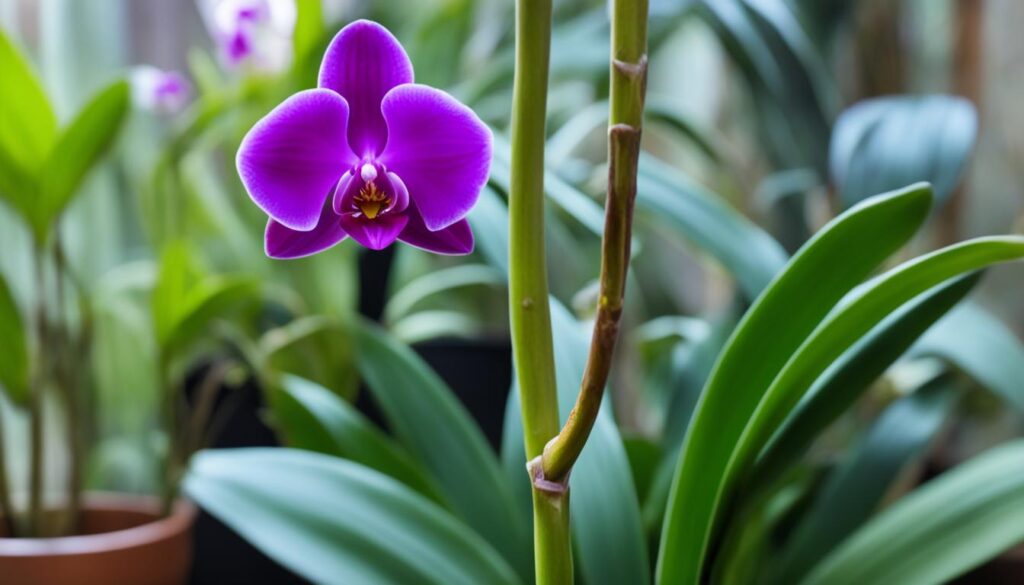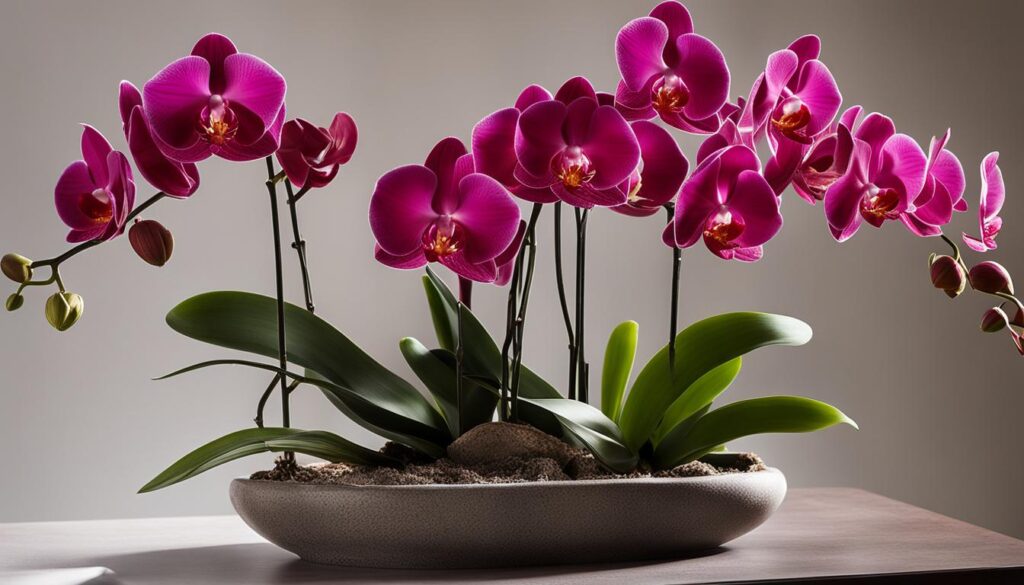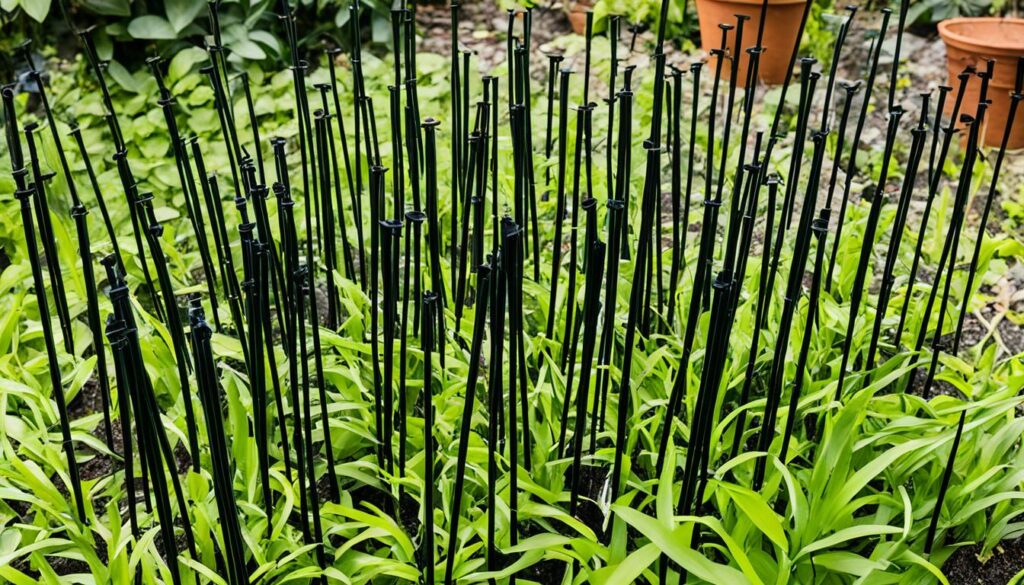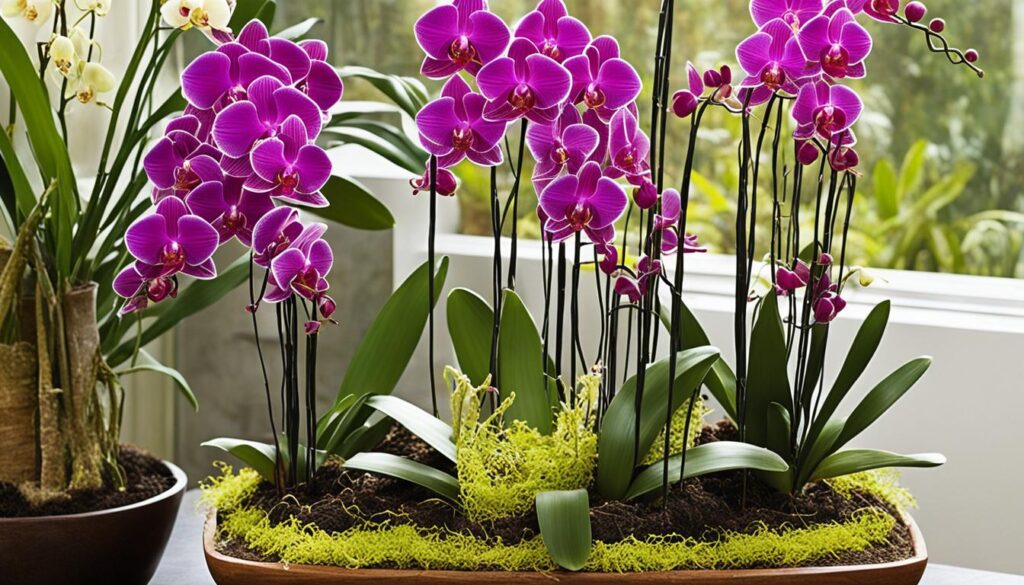As an enthusiast of the exotic beauty that orchids embody, I’ve come to realize the importance of effective orchid support and orchid staking in the broader spectrum of orchid care.
The allure of these blooms is not just in their vibrant colors and unique shapes but also in how they are presented.
Mastering how to support orchids plays an integral role in this presentation, providing a structure that elevates their appearance.
Let’s delve into the world of orchid trellis and staking to ensure our blossoms can truly stand out.
Key Takeaways
- Understanding the necessity of proper support to maintain the health and aesthetics of orchid blooms.
- Exploring various orchid staking strategies tailored for different species, such as phalaenopsis and oncidiums.
- Emphasizing how the correct timing for staking is essential for ideal flower development.
- Choosing the right materials for orchid support, including stakes and ties, to enhance natural beauty.
- Providing a step-by-step guide on securing the flower spike to achieve the desired presentation.
- Acknowledging that creativity in staking can be functional and visually appealing, enhancing the overall enjoyment of orchid care.
Understanding the Need for Orchid Support
When I first embarked on my orchid care journey, I quickly realized that the mesmeric display of orchids is not solely the work of nature.
It involves a dab of human ingenuity in the way we use orchid support clips and stakes to preserve the inherent beauty of these blooms.
It’s a symbiosis of art and science, ensuring the orchid’s majesty is uncompromised, and its blooms are showcased to full effect.
Heavy Blossoms Require Careful Staking
Heavy blossoms can be both a blessing and a curse. Their voluptuous presence is eye-catching, yet without proper stake support, they tend to sag, taking away from the plant’s natural elegance.
Utilizing orchid support stakes, I nurture the plant’s growth, preserving the stems and that sought-after upright appeal.
The Aesthetic Benefit of Proper Support
Meticulous positioning of orchid support clips guarantees not just stability, but also the polished look that makes casual viewers and judges in orchid competitions take notice.
The goal always is to ensure the stakes and clips do their job without stealing the spotlight, allowing the natural allure of orchids to take center stage.
- Maintain the plant’s vertical lines for a tidy appearance
- Prevent potential bloom damage during transport
- Enhance the visibility of flowers for display and competition
“With careful application of support clips and stakes, the true splendor of an orchid can be realized in its displays, reflecting well on the caretaker’s skill in orchid care.”
| Support Tool | Purpose | Benefits |
|---|---|---|
| Orchid Clips | Secures bloom spike | Prevents drooping and maintains orientation |
| Staking Rods | Provides a backbone for the stem | Supports heavy blossoms, enhances aesthetic display |
| Twist Ties | Adjustable attachment | Easy to reposition for optimal growth support |
The Right Timing for Staking Orchids
As someone keenly interested in the best orchid support methods, I understand how imperative timing is in the pursuit of perfect blooms.
The essence of orchid care hinges on not only knowing how to support orchids but also recognizing the prime moment to introduce support.
That critical period is when the buds have formed but remain unopened, a preemptive measure that pays dividends in presenting a mesmerizing floral display.
By implementing support early, one directs the buds to face the optimal angle, thus allowing for their magnanimous bloom into a splendid display.
It prevents the all-too-common issue of having to reposition the flowers post-bloom, which can result in an awkward appearance and even damage the delicate petals.
I’ve compiled a list of orchid support ideas that coincide with this timely approach, ensuring your orchids receive the staking they require, exactly when they need it:
- Analyze the growth pattern weekly and prepare to stake once the first buds are noticeable.
- Choose stakes that complement the orchid’s height and structure, so support is both aesthetic and functional.
- Gently tie the spike to the support, ensuring no harm comes to the buds or stem.
- Maintain a vigilant eye on the developing flowers, adjusting ties as necessary without disturbing the bloom.
It is through this proactive approach that one is rendered capable of orchestrating a display of orchids that commands attention and envy.
Comprehending the accurate period for staking orchids is less about the singular act and more about weaving a narrative of care that results in resplendent beauty and vigor.

Reflecting on the significance of timing in providing the best orchid support, one cannot help but draw parallels with artistry, for just as an artist envisions the brushstroke before the paint is applied, so must the orchid aficionado anticipate the needs of their floral canvas, delivering support that seamlessly blends with the emerging masterpiece.
Orchid Support and Staking for Different Species
As an orchid enthusiast, I’ve learned that each species of this exotic plant has its unique requirements for support and staking.
Effective orchid support systems not only contribute to the health of these stunning plants but also enhance their beauty.
Join me as we delve into the specifics of staking techniques tailored to various orchid species, focusing on ensuring their blooms are displayed to their full potential.

Staking Techniques for Phalaenopsis and Oncidium
When it comes to the elegant sprays of Phalaenopsis and Oncidium orchids, precision is key. The use of orchid support systems here is critical, especially as these species develop long flower spikes.
To manage their graceful arching form, I recommend using a blend of ties and stakes early in the growth cycle when the spikes are just developing.
This proactive approach allows you to guide the flowers into an appealing spray that captures the eye and heart of any observer.
Unique Approaches for Cattleyas and Paphiopedilums
For orchids like Cattleyas and Paphiopedilums, each requires a unique touch. These varieties often exhibit shorter stems and may need a gentle nudge in the right direction to present their blooms at the most engaging angle.
Sometimes, it’s about adjusting the angle of the pseudobulb, while at other times, creating a stable support structure with hooks and wires is essential.
These longer-term orchid staking techniques ensure that the plant matures into a display that will captivate and mesmerize through the entire blooming period.
By understanding these differences between species, you can create an orchid trellis or support that’s both practical and visually beautiful.
The goal is always to display these enchanting flowers in such a way that they appear effortless and natural, as though the supports are but a whisper, unnoticed in the grandeur of the blooms.
Selecting the Appropriate Stakes and Ties
When it comes to orchid staking, the choice of support tools strongly influences the presentation and health of the orchids.
My objective is always to choose orchid support stakes that are as pleasing to the eye as they are effective.
For those seeking the best orchid support, I’ve found bamboo stakes to be aesthetically seamless and environmentally friendly.

Metal stakes, on the other hand, offer a different kind of flexibility which is invaluable when dealing with uniquely-shaped orchid blooms.
The inclusion of both bamboo and metal options allows orchid enthusiasts to address the varying structural needs of different orchid species.
| Stake Material | Benefits | Best Used For |
|---|---|---|
| Bamboo | Natural look, sturdy support, eco-friendly | Straightforward staking of most orchid types |
| Metal | Flexible, can be manipulated for shape | Orchids with unique floral arrangements |
As for ties, my approach is always gentle. The market has an array of twist ties and clips designed to be gentle on orchid stems, preventing damage.
It is key that whatever is used for tying does not pinch or restrict the stem’s natural growth.
- Select ties that are easy to adjust or remove;
- Ensure ties are snug but not tight;
- Avoid wire ties that can cut into the stem.
In my experience, a combination of the right stakes and ties, along with careful attention to the plant’s needs, results in an orchid display that is both stable and striking.
Securing the Flower Spike: A Step-by-Step Guide
How to support orchids effectively is a question that troubles many gardeners. The key to achieving a well-maintained orchid is not only about providing adequate light and water but involves proper staking methods which form an integral part of comprehensive orchid care.
As someone with a passion for these exquisite plants, I’ll share how you can artfully secure your orchid’s flower spike, ensuring it stands tall and blooms beautifully.

Positioning and Inserting the First Stake
When I begin the orchid staking process, I carefully choose a suitable stake that matches the height of my orchid’s anticipated growth.
The first step involves positioning this stake close to the plant’s base without disturbing the roots. I gently insert the stake into the potting medium, taking care to avoid any root damage which can occur if done hastily.
This initial placement sets the trajectory for the spike’s upward growth and lays the foundation for the subsequent steps.
Attaching Additional Ties for Stability
After the stake is securely in place, it’s time to attach ties for stability. I use soft, flexible ties to avoid any damage to the delicate stem.
Starting from the lowest, I affix the ties at strategic intervals along the stake, ensuring each is snug but not overly tight. This method offers the spike the support it needs to grow straight and prevents any awkward bending that might occur due to the weight of the blooms.
Maintaining Proper Orientation to Light
Orchids are light-hungry plants. To encourage a uniform direction of growth, it’s pivotal to maintain a proper orientation to the light source, even after staking. I rotate my orchid pot regularly, promoting an even exposure which prevents the orchid from leaning towards the light.
This care ensures the spike grows upright with flowers developing a natural arch, presenting a showcase-quality bloom.
Orchid Support and Staking: Creativity Meets Functionality
My personal journey with orchid staking began as a strict adherence to functionality, ensuring each stem was supported and structured correctly.
However, as I delved deeper into the intricate world of orchid care, I discovered that there’s much more to it. Incorporating creativity into the process not only enhanced the appearance of my orchids but also allowed me to connect with them on a new level.
Developing orchid support ideas became a delightful pastime that married the needs of my plants with my own artistic aspirations.
Boldly bending wires to create custom flower hooks and ties catered to the specific contour of each orchid, I began seeing staking as a form of art – an expression of care and contemplation.

As an orchid enthusiast, I soon realized that practical function could coincide with aesthetic grace.
The right orchid staking approach can transform a drooping spike into a soaring floral arrangement that not only appears more vivacious but also embodies the unique character of each bloom.
Similar to a sculptor minding the natural lines of marble, I learned to observe the natural tendency of an orchid’s growth, utilizing various resources to enhance rather than modify its inherent beauty.
- Bending soft wires into custom shapes for unique support
- Creating loops and hooks for delicate stem guidance
- Utilizing everyday materials for innovative support solutions
Not only has my exploration into creative staking added a layer of personal satisfaction to the nurturing process, but it has also sparked conversations and interest among fellow growers.
The exchange of techniques and ideas around orchid support has become a bonding experience that elevates our shared passion for these enchanting plants.
I encourage you to view orchid staking not just as a necessary task, but as an opportunity to experiment and express your creativity.
Each orchid presents a new canvas to explore fresh ideas, you may find that your innovative support does more than just uphold, it inspires.
Common Pitfalls and How to Avoid Them
When it comes to crafting the perfect environment for your orchid’s growth, understanding how to deftly handle an orchid trellis can be as crucial as selecting the right potting mix.
Orchid enthusiasts must be particularly cautious to avoid the common yet avoidable slips that can lead to unhealthy plants and unattractive displays.
In my experience, paying due attention to the right use of orchid support clips and stakes can make a significant difference.
Avoiding Damage to the Stem During Staking
Damage to orchid stems during staking is a mishap that can easily occur if not attentive. I recommend using soft materials like cloth-wrapped wire, which can gently secure the plant without biting into its flesh.
Additionally, employing orchid support clips made from supple, non-abrasive materials can safeguard your orchids from unnecessary harm.
Remember, the stakes are not just a skeletal support but also the cradle that nurtures your orchid’s elegant posture.

Ensuring an Unobtrusive and Natural Presentation
Ensuring a display that mimics an orchid’s natural gracefulness is another key step I’ve learned is vital. The strategic use of orchid support stakes can guide the plant to an upright position, mimicking its preferred growth in the wild.
My approach is to always arrange the support so that it fades into the background, highlighting the beauty of the blooms rather than the mechanics of their support.
“A harmonious orchid display is one where the support system is invisible, allowing the natural beauty of the blooms to take center stage.”
To elucidate some of the materials suitable for these purposes, I’ve compiled a table listing options for orchid support that emphasize protection and aesthetic integration.
| Support Type | Material | Benefits | Suitable For |
|---|---|---|---|
| Orchid Stakes | Bamboo, plastic-coated metal | Sturdy, can be cut to desired length | Taller orchid varieties |
| Support Clips | Soft silicone, gentle plastic | Easy to clip on and remove, minimal damage | Stems requiring subtle guidance |
| Cloth-wrapped Wire | Flexible wire covered with a soft cloth | Customizable shape, gentle on stems | Delicate or uniquely shaped blooms |
Remember that when staking orchids, the goal is to mirror the natural arch and inclination of the stems, sometimes requiring creativity and an eye for design.
This means that while using an orchid trellis, orchid support clips, and support stakes are fundamental to orchid care, the ultimate aim is to enhance, not dominate, the natural floral exhibition.
Conclusion
As a passionate cultivator of orchids, I’ve learned that the practice of staking is far more than a mere gardening task; it’s an artistic endeavor that marries beauty with practicality.
Through a careful application of the staking techniques discussed, from knowing when to tie the blooms to selecting the best orchid support, I’ve witnessed first-hand how a thoughtfully stalked orchid can transform into a captivating display.
For those who seek to ensure the longevity and vibrancy of these exquisite plants, becoming adept in orchid care is both a satisfying and visually rewarding pursuit.
Embracing the Art of Orchid Staking for Impressive Blooms
Embracing the art of orchid staking is crucial for anyone longing to elevate the aesthetics of their blossoms.
To achieve impressive blooms, I’ve integrated numerous orchid support ideas into my care routine; these have undoubtedly become as influential in my garden as proper watering and lighting.
These methods, which I’ve explored with enthusiasm, signal a dedication to presenting the orchid in its most flattering form, ensuring each flower can reach its full, stunning potential.
Reflecting on the Rewards of Thorough and Thoughtful Support
As my experience with these enchanting plants has deepened, so too has my understanding of the importance of meticulous support. The fruits of such labor, the unequivocal magnificence of the orchids, are a testament to the effectiveness of thorough and considerate staking methods.
I take immense pride in the fact that the labor of my hands contributes to the health of my plants, and in turn, rewards me with bountiful, splendid blooms that exude natural charm and a spirit undiminished by their supports.
FAQ
Why is orchid support important?
Supporting orchids is important to prevent heavy blossoms from opening at awkward angles, ensuring an aesthetically pleasing presentation, and protecting the plant from damage, especially during transport. It also aids in the proper positioning of blooms for both casual viewing and competitive exhibitions.
When is the best time to start staking orchids?
The best time to start staking orchids is when buds are present but before they have opened. This allows you to guide the buds so they will bloom in the optimal direction without trying to reorient an already opened flower.
What are the key considerations for staking different types of orchids?
Different types of orchids require specific staking techniques. Phalaenopsis and oncidium orchids, which have long spray-type spikes, can be supported with ties and stakes early on. Cattleyas and paphiopedilums may need adjustments to the angle of the pseudobulb or the use of hooks and wires for support due to their varied growth patterns and blooming styles.
How do I choose the right stakes and ties for my orchids?
Choose stakes and ties that blend with the plant and provide solid yet flexible support. Bamboo stakes are firm and natural-looking, while slender metal stakes may be used for more unique floral arrangements. Ties and clips should secure the stem without causing damage or taking away from the orchid’s appearance.
Can you explain the step-by-step process of supporting an orchid spike?
To support an orchid spike, first insert a stake close to the base, taking care to avoid damaging roots, and then tie the stem to the stake at strategic points for optimal support. Make sure to maintain the correct orientation to light so the flower spike grows upright and blooms in a uniform direction.
What creative methods can be used for orchid staking?
Orchid staking can involve bending wires to make flower hooks or using a variety of available materials for ties. The creativity in staking comes from adapting the support to each orchid’s unique shape and flowering pattern, enhancing the plant’s natural beauty.
How can I avoid damaging my orchid when staking?
Be gentle and use soft materials like cloth-wrapped wire or gentle clips to prevent injury. Avoid over-tightening ties and be mindful of the plant’s growth and light orientation, so there’s minimal need for repositioning. Always stake with a light touch and do not reuse staking materials to prevent disease spread.
Why should the presentation of supported orchids be unobtrusive?
An unobtrusive presentation ensures that the natural elegance of the orchid is not overshadowed by the support system. It allows viewers to focus on the flowers themselves, rather than the mechanics behind their display, creating a more natural and appealing look.


Leave a Reply